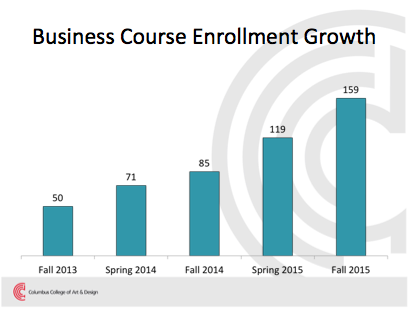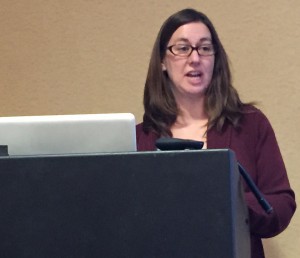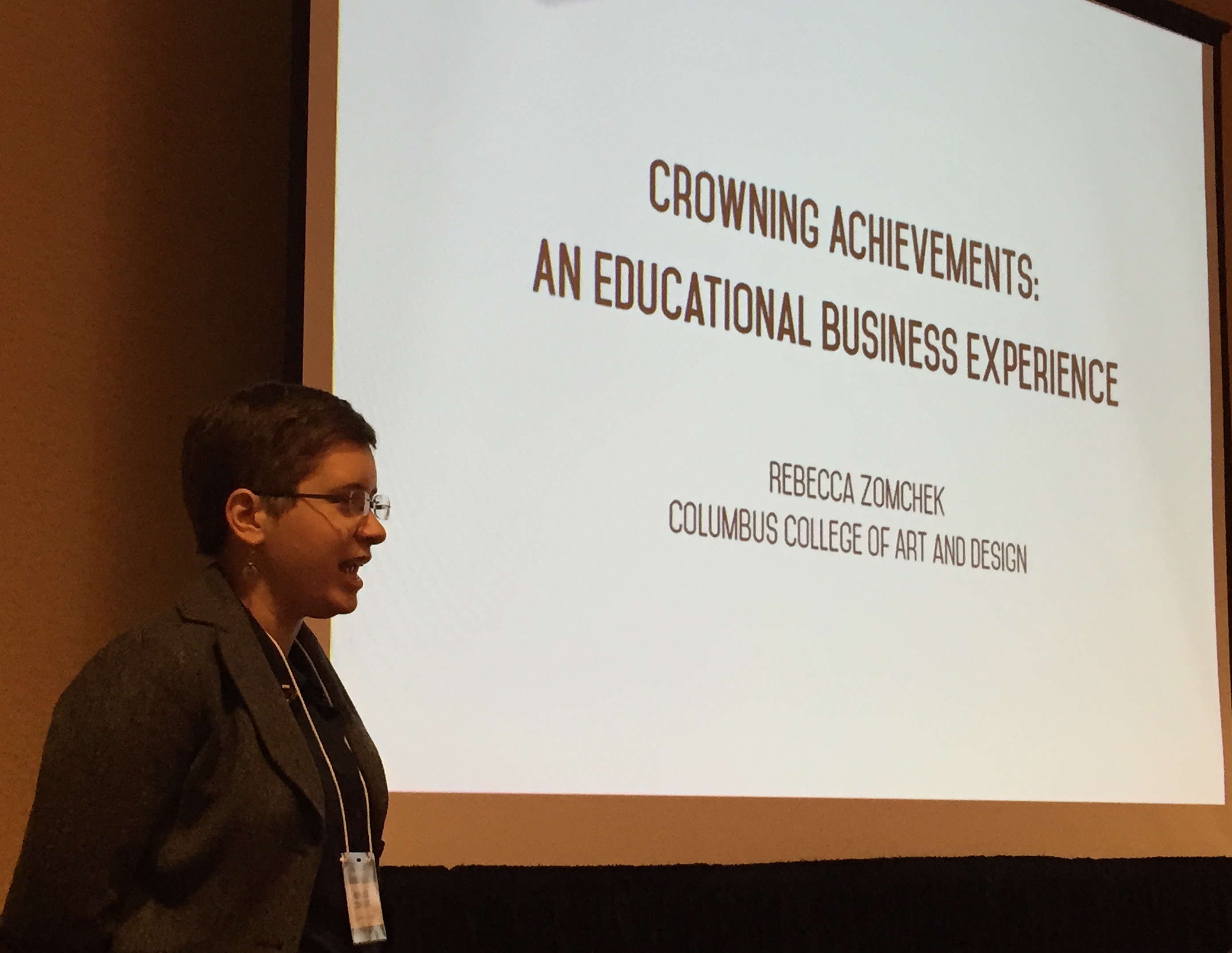October 26, 2015 • Curriculum
On Saturday, I chaired a panel discussion on Fluid Borders in Business, Art & Design at SECAC (the Southeast Conference of Arts Colleges) in Pittsburgh. What follows is a transcript of my remarks, and a brief summary of two panelists’ presentations. Enjoy!
Fluid Borders
Welcome to Fluid Borders in Business, Art, and Design, a conversation about the messy overlap in curricular outcomes and how those overlaps can best serve our students.
My name is Elaine Grogan Luttrull, and I am the Department Head for Business & Entrepreneurship at the Columbus College of Art & Design in Columbus, Ohio. Our Business & Entrepreneurship department has existed for one full academic year (plus four months or so), but its foundation was laid years earlier as a group of wandering adjuncts, with strong support from our Provost, Kevin Conlon, sought to build business curriculum for students of art and design.
 We became a real department, with one full-time faculty member (me) during the 2014-15 academic year, when we served 204 students (224% growth over the previous year!) through four core classes. This year, we are on track to serve approximately 280 students, which represents a 36% growth over the previous year. (And serving about 275 students per year is our “steady state” goal.)
We became a real department, with one full-time faculty member (me) during the 2014-15 academic year, when we served 204 students (224% growth over the previous year!) through four core classes. This year, we are on track to serve approximately 280 students, which represents a 36% growth over the previous year. (And serving about 275 students per year is our “steady state” goal.)
We expect our course offerings to grow next year to seven regularly scheduled courses (plus one or two special topics or honors courses as appropriate), and a robust offering of integrated curriculum, including a first-year CORE class with embedded business content. (But that’s the subject for a future presentation.)
For all our courses, workshops, and embedded curriculum, we follow the Tailored Technical Model of Active Engaged Learning, which means technical experts in the business fields (a CPA, an attorney, etc.) lead classes with curriculum tailored specifically for our student population (artists and designers). While there will always be some lecture component in our courses (experts need to share their expertise, after all), the majority of our curriculum is built around active engagement, including online discussions, and deep reflections on readings and materials.
We live in this delightfully messy world, in which business professionals intersect with art students, design professors, community partners, and governmental entities, each bringing its own experiences and expertise to the conversation. In that spirit of delightfully messy community, today’s theme, Fluid Borders, is getting the right people together to solve social problems, career problems, and business problems through our curriculum. We’ll hear about two student-focused projects and one industry-focused endeavor from our three panelists. All involve challenges, setbacks, successes, and victories, and by exploring the messiness and the overlap in what we do, we’ll be better poised to use our creativity in serving our students and preparing them for sustainable, professional, creative careers.
Belinda Haikes

Belinda Haikes is a conceptually driven interdisciplinary artist, designer, and writer whose work examines digital and social relationships. Her work has been included in exhibitions and screenings both domestically and abroad, and she was recently the recipient of AIGA Design Educators Grant. Belinda holds a PhD from VCU’s Media Art and Text program and an MFA from the Pennsylvania Academy of Fine Arts. She is an Assistant Professor in the Department of Art at the College of New Jersey, and she is currently trying to leave the world a little better than she found it.
Belinda’s presentation focused on a project she created called Linked Lives, in which a designer, a scientist, and a technologist joined forces along with students and community stakeholders to raise awareness about a key problem in Philadelphia: Soil contamination. Currently, knowledge about this issue is only shared through informal community channels (for example, a neighbor suggesting that Belinda not eat vegetables she had grown in her garden because of contamination that occurred three generations prior). It is vital to capture and preserve this community knowledge, particularly as the residents of neighborhoods change over time. Design, science, and technology can help with that.
This project underscores Design for Good, a key component of Belinda’s professional design work, and it establishes opportunities for students to invest in their community beyond the classroom setting. Students would complete the (paid!) work on this project over the summer, and the results would be shared via open source with stakeholders, the community, citizen scientists, students, faculty, and the scientific community at large.
Funding to continue this project is pending, and our fingers are crossed students will have an opportunity to pursue this design work, which really focuses on using design to improve communities through deceptively simple communication solutions.
Rebecca Zomchek

Rebecca Zomchek is an illustrator and hand letterer who graduated with an MFA from the School of Visual Arts in New York and a BFA in illustration, summa cum laude with honors, from Syracuse University. Rebecca works as an editorial illustrator, concept artist, and children’s book artist, and she is an Assistant Professor of Illustration at the Columbus College of Art & Design. She is also the co-director of the CCAD Women’s Leadership Institute.
For her presentation, Rebecca described a four-week co-curricular project involving ten CCAD students and two faculty advisers. The students were charged with creating “fresh, new design ideas” for a national greeting card company, while balancing the company’s overall aesthetic and history with the sensibilities of a younger audience. (No easy feat!)
Of course, the students learned about working with clients, responding to client requests, reading between the lines of client feedback, and general artistic and design skills in researching the greeting card industry and noting certain display quirks. (For example, the top third of a card is all anyone sees when the cards are displayed in a store’s “stack,” making the top third of a card prime real estate for the designer.)
But Rebecca discussed many of the accidental lessons the students appreciated as well, particularly those that cannot be replicated in a classroom setting, no matter how diligently the instructor prepares. For example, students and the faculty participated in a kick-off call with the client, and as is often the case, there was a last-minute contract change proposed by the client right as the call was starting. The students witnessed the faculty members negotiating the new terms with the client in real time, observing the vocabulary, tone, and rationale used by the faculty members to push back on certain terms, while accepting others. What’s more: After the call ended, the faculty members and students talked about the conversation, reflecting on certain points and underscoring teachable moments that accidentally emerged from a simple contract negotiation. Such learning proved invaluable to the students, and opened up a moment of learning that usually doesn’t occur in the classroom.
And like with Belinda’s Linked Lives project, the CCAD students were paid for their work (a $400 flat fee), and the two faculty advisers were paid for their coaching and mentoring services as well.
Fluid Borders Conclusion
As long as there are creative instructors, like Belinda and Rebecca, who are willing to explore the messy overlap in teaching students about their community, the world around them, and their business savvy in addition to art and design skills, our students will continue to thrive.
My favorite moment of the entire panel was when an audience member asked if the students involved in Rebecca’s project were graduate students, based on the quality of portfolio work Rebecca showed. (Note, she could not show actual student work from the project because of an existing NDA, but she was able to show unrelated portfolio pieces from the students involved.) Nope, Rebecca replied with a grin. That’s a junior’s work. And she’s incredible.
Indeed.


